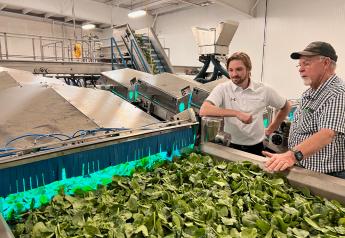Retailers have options with promotions, marketers say

Though COVID-19 has taken away the opportunities for in-person sampling and other strategies, retailers have plenty of apple promotion options, marketers say.
One approach, said Brenda Briggs, vice president of sales and marketing for Rice Fruit, Gardners, Pa., is to bring creativity to bagged apple displays.
“There are going to be plenty of packaging options, from poly bag, pouches and totes and sizes will range from 2-pound, 3-pound and 5-pound,” she said.
Promoting local apples also is a winner, Briggs said.
“Take the opportunity to promote local and feature the family businesses in your region to connect the consumer — consumers want to support their community!”
Briggs said Rice Fruit has seen consumer interest during the pandemic to keep their dollars local, to purchase bagged items and to opt for online, pick-up or self-check out shopping preferences to limit engagement with others.
“To meet the increased grab-and-go demand, we have expanded our options in poly, pouch, and totes to remain nimble to our customer needs,” she said.
“The Honeycrisp variety continues to drive demand, followed by gala, fuji, granny smith, and Pink Lady. We also have seen an uptick in sales for golden delicious, as they are a familiar favorite variety to have on the shelf to break up the wide array of red apples.”
Retailers should display apples front and center, with clear markings of varieties, said Cynthia Haskins, president and CEO of the New York Apple Association, Fishers. Including a flavor profile reference and use guide also is important, she said. “(The) younger demographic enjoys newer varieties, but don’t forget that the plus-54 demographic are some of the biggest apple eaters, so market to both,” Haskins said.
Stay nimble
Multi-variety ads are a key for the apple category, said Brianna Shales, marketing director at Stemilt Growers, Wenatchee, Wash.
“There is a tendency to run one variety (Honeycrisp) on ad and that drives Honeycrisp volume, but doesn’t always drive apple dollars up,” Shales said.
“We need to promote Honeycrisp, but alongside other core varieties like gala, fuji, Pink Lady and others.”
Bags are going to remain in favor while COVID-19 is present, she said, as bagged fruit helps shoppers stock up and reduces grocery trips.
Still, Shales said bulk displays are still the primary way apples are sold, so retailers should look to reinvented options like tote bags to move volume.
“For proprietary varieties, we suggest picking a mix that works for your shoppers and promoting one alongside that multi-variety ad or as an in-store/digital callout,” she said.
“Don’t forget to tell the story of the new variety because consumers — whether purchasing in-store or online — need a reason to try something new.”
Online grocery and produce purchasing is on the rise and Shales said Stemilt is making sure its branded items are represented correctly online to maximize sales.
“We are excited to work with retailers in 2021 and beyond to help market apples in this omni-channel environment,” she said.
Angela Sommers, marketing director of Belding, Mich.-based Belleharvest Sales Inc., said the company’s strategy will be focused around carefully managing volume and expectations at retail.
“With a smaller national crop, we need to work collectively to keep dollars up,” Sommers said. “We are focused on promoting several of our core varieties along with new innovative apples, such as Smitten.”
With the change in shopping habits due to the pandemic, consumers are reaching for bags with bigger pack sizes, Sommers said.
“This is a great way to move bulk fruit that may not be trending at retail. Most importantly, we must stay persistent to keep the upward momentum that is occurring within the category.”
Retailers must keep their focus on both bulk and bagged apples between now and March, said Chuck Sinks, president of sales and marketing for Yakima, Wash.-based Sage Fruit.
“While many consumers are using bagged fruit there are still plenty of shoppers looking for bulk apples. I would suggest running ads that carry both type of items in their selections. Retailers also need to mange their SKUs. Don’t let your departments get overrun with new proprietary apples and confuse the consumer. Have a plan,” he said.
Retailers can maximize sales by building in-store displays for traffic interruption on relevant varieties, and by carrying high quality products, said George Harter, vice president of marketing for CMI Orchards, Wenatchee, Wash.
“Unsurprisingly, retailers have been experiencing a migration towards less traditional shopping methods with a massive growth in online sales,” Harter said.
“This transition was already slowly occurring; however, (it) has been fast-tracked as fewer shoppers want to visit physical stores and instead prefer to shop from the comfort of their homes.”
Targeting online
It is important for retailers to start targeting their online shoppers and use their baskets as a tool to get them to sample new items, said Alisha Albinder, owner and operations manager for Hudson River Fruit Distributors, Milton, N.Y.
“If someone buys the same apple bag every week, maybe send a sample of a new apple at a higher retail and see if it gets the consumer to switch over — same with getting people to try new items,” Albinder said.
“Everyone loves a free sample and this is the best way to target very specific items!”
Retailers can try several promotion approaches, said Kristi Harris, marketing manager for Elgin, Minn.-based Honeybear Brands, Some of those approaches, she said, include:
- Employ merchandising and pricing to shift consumers up from commodity apples to premium apples;
- Maintain slightly higher margins on legacy varieties with slightly lower margins on emerging varieties;
- Do not undercut premium apple pricing. That, she said, creates incentives for consumers to trade up to premium apples to drive dollars;
- Adopt a pricing strategy that allows consumers to trial premium apples but doesn’t train them to purchase only when on ad (tiered pricing);
- Build category image/leadership around selected premium varieties that highlight exclusivity;
- Caution should be used with Honeycrisp pricing as price cuts may not drive incremental volume; and
- Be assertive in providing varietal information at point of sale to motivate consumer trial.







